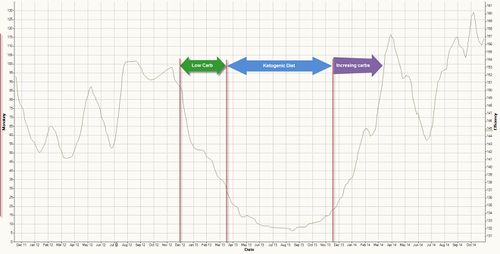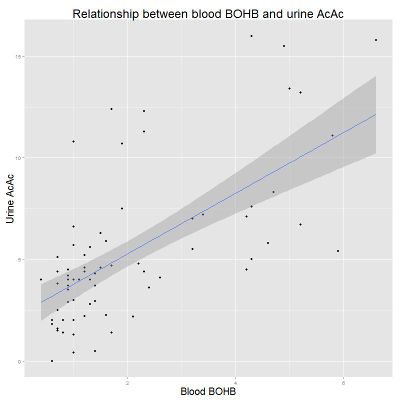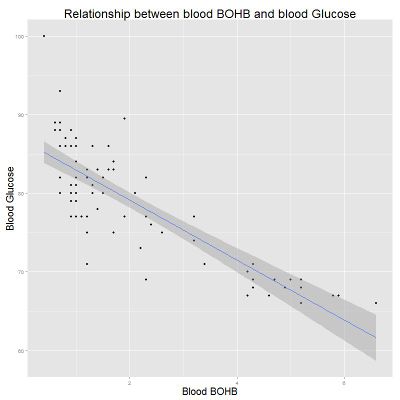Ketogenic Experiment
I used the Ketogenic Diet for 7 months, running an average of 70 miles/week, peaking at 200 miles/week, including over 50 marathon length runs. I was surprised how little impact the Ketogenic Diet had on my running, and I could maintain my training regime without difficulty. However I was not able to race successfully on the Ketogenic Diet and I found the Ketogenic Diet difficult to comply with.
Contents
1 Background
As an ultrarunner, I've experimented with Low Carbohydrate Diets (LCD) before with little success. I found that running on LCD let me feeling like I was permanently Glycogen depleted. However, after reading The Art and Science of Low Carbohydrate Performance and Ketogenic Diets: Treatments for Epilepsy and Other Disorders I decided to experiment with a Ketogenic Diet which is quite different from most general Low Carb Diets.
2 My Ketogenic Diet
- I was on the Ketogenic Diet from March to November of 2013 (~7 months).
- For some of the time I was on the Ketogenic Diet I analyzed my food in detail. During this time my average diet was 3,740 Calories/day, 357g fat, 53g carbs, 27g fiber (26g Net Carbohydrates), and 88g protein. This is a Ketogenic Ratio of 3.13:1, and the calories ware 87.6% fat, 2.8% carbohydrate, 9.6% protein.
- I found the ketogenic diet remarkably hard work and tiresome. The food choices were grim, and it was not really possible to eat anything even vaguely like normally. Even bacon was too low in fat to be eaten freely.
- I found my body fat dropped to its lowest level ever. However, I'm not sure how much of that is the Ketogenic Diet directly and how much is because I was analyzing everything I was eating, so I was far more aware of any excess calorie intake. Another possibility was that the weight loss was because my appetite was dramatically lower on the Ketogenic Diet, especially at the beginning.
- I experimented with Medium Chain Triglycerides, but I found that MCT hindered my running performance.
- I seemed to have more migraines on the Ketogenic Diet, though my migraines are not predictable enough to be sure.
- I had more problems with my skin condition on the Ketogenic Diet, though with hindsight I suspect this was due to an insufficient Vitamin C intake.
3 Ketone Levels
I used a blood ketone meter from May to ensure my Ketone levels were sufficiently high and to evaluate what factors impacted my levels. I measured my Ketone levels first thing in the morning and also during some of my long runs. During the time I was measuring my Ketones, the average level was 2.0 and ranged from 0.2 to 6.8. I also checked my blood glucose levels, and my average morning level was 78. The charts below show the relationship between the values, with the regression line in blue and the 95% confidence intervals shaded. As you can see, for my readings there is better correlation between blood glucose and blood BOHB than there is to urine AcAc. I tried adjusting for hydration using the Urine Specific Gravity values from the test strips, but this made little difference to the correlation. Multiple regression of blood glucose and urine AcAc to blood BOHB did improve the model to r2=0.73.
4 Ketoadaptation
The advice from books like |The Art and Science of Low Carbohydrate Performance is that Ketoadaptation takes at least two weeks, and the classic study by Phinney used four weeks to ensure complete adaptation. My experience fitted in with this guidance and for the first couple of weeks running was much harder. My Heart Rate (HR) and Breathing (Respiration Rate, RR) was much higher than I would expect for the given pace. It also seemed like my RR went through cycles; at some points the RR would be what I would expect for the elevated HR, and then increase so that my RR was higher than expected, before lowering again. This would repeat every few minutes. After Ketoadaptation my running felt similar to how I feel on a high carbohydrate diet. However, an analysis reveals that my HR was higher than it would be on a high carbohydrate diet (see "Running Economy" below.)
5 Ketogenic Running
- I found I had no problems running marathon distance training runs without any fueling on the Ketogenic Diet, but I can also do that on a high carbohydrate diets.
- Taking small amounts of carbohydrate during a long run could be done without impacting my Ketone Levels, but too much would cause the levels to drop precipitously. To my disappointment, the extra carbohydrate did not seem to reduce my fatigue or improve performance. I also tried taking extra fat, or mixtures of fat/carbs/protein, which seemed to help a little.
- While I could run the marathon distance without fueling, running longer distances required some type of fueling. I discovered I could still 'crash' on the Ketogenic Diet, though it is a softer, slower crash than a blood glucose/Glycogen depletion crash. My suspicion is that I ran out of available fat to use a fuel, even though obviously I had plenty of body fat left. Part of the issue might have been a depletion of intramuscular triglycerides which on a high carbohydrate diet provide about the same amount of fat calories as plasma fatty acids. However, the other issue might be the rate of lipolysis, which is the breakdown of body fat. It's possible that I was running out of usable body fat.
- I found that I could put on upper body muscle using weight training much better on the ketogenic diet. However, my leg muscle mass was reduced on the Ketogenic Diet.
- I was able to handle far higher training volumes without it impacting my Mood State, especially when my mileage hit 200 miles/week.
- I had two runs on the Ketogenic Diet where I experienced a strong feeling of euphoria. The first time the euphoria occurred from mile 16 to 26 of a normal training run. The second time was a shorter 10 mile run with sore legs, where I noted a strange combination of fatigue, soreness and euphoria. I never worked out what caused this euphoria or found a way of reproducing it. I had one other run where I noted "running 28 miles should not be this easy", and would have run much further had time allowed.
6 Ketogenic Ultramarathons
I raced three times on the Ketogenic Diet; the Midnight Boogie, Laurel Valley and Hinson Lake 24.
- The Midnight Boogie is a 50 mile race in the heat of the North Carolina summer. I started running without calories and felt fine for the first 26 miles, at which point things "went squirrely". I took at GU at mile 29, which helped enormously, and I finished the race in 8.54. That's not a terrible result, but it was slower than I'd have expected (I've won the race in 7:04 previously.) After the race my Blood Ketones were 3.1 and my Blood Glucose was 105.
- For Laurel Valley I took things easy, and sadly I made no useful notes in my training log.
- Hinson Lake 24 Hour was a disastrous race. By mile 24 my blood pressure was low, my breathing was strained, my blood ketones were 0.8, and blood glucose 108. At mile 26 I started to suffer from Nausea, but I continued to push on until mile 42 when my blood pressure was too low to stand. After some medically trained runners took care of me for some time, I recovered enough to walk another lap (~1.5 miles), then run a lap, before retiring from the race.
7 Running Economy
The graph below is of my Relative Running Economy over the three year period that includes the time I was on the Ketogenic Diet. As you can see my Running Economy was lower on the Ketogenic Diet than with more carbohydrates. This is what I would expect, has fat requires more oxygen to produce a given amount of energy compared with carbohydrate.

8 Conclusion
Here are my personal conclusions based on my interpretation of the scientific evidence available and my own personal experience.
- I believe that there are some huge benefits as well as equally large risks associated with the ketogenic diet. Therefore, I find myself neither an advocate for the ketogenic diet nor a naysayer. Instead, my recommendation is for each person to weigh up the pros and cons based on their particular situation, and make an informed decision.
- I recommend medical supervision for the ketogenic diet. It's possible to act as your own doctor for the ketogenic diet as I did, but this increases the risks and requires that you do far more research. You need to be comfortable with handling your own medical tests and supplementation.
- More to follow.
9 See Also
- The classifications and types of Low Carbohydrate Diet.
- An introduction to the Ketogenic Diet.
- My experiences with ultrarunning on the Ketogenic Diet
- My Ketogenic Recipes
- Non-Ketogenic Low Carbohydrate Diets

